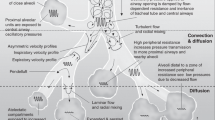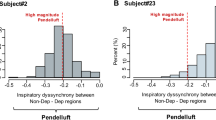Abstract
Two infants on high-frequency oscillatory ventilation for chronic lung disease and severe respiratory failure, received a bolus of warmed and oxygenated perfluorodecalin up to residual functional capacity, followed by a continuous infusion of 6 ml/kg/hour. Our aim was to improve gas exchange without increasing ventilatory-induced lung injury. Heart rate, oxygen saturation, blood pressure, and TcPO2/TcPCO2 were continuously monitored during treatment. Arterial blood gas was evaluated every 3 hours. Both patients showed improvement of gas exchange with a 13.6 and 12.5% reduction of oxygenation index, respectively. High-frequency partial liquid ventilation is an experimental ventilation technique that could be considered as rescue treatment, to improve oxygenation in subjects with critical respiratory failure. This method could probably produce less damage, than other ventilation modes, to severely injured lungs.
This is a preview of subscription content, access via your institution
Access options
Subscribe to this journal
Receive 12 print issues and online access
$259.00 per year
only $21.58 per issue
Buy this article
- Purchase on Springer Link
- Instant access to full article PDF
Prices may be subject to local taxes which are calculated during checkout


Similar content being viewed by others
References
Greenspan JS, Wolfson MR, Rubinstein SD, Shaffer TH . Liquid ventilation of human preterm neonates. J Pediatr 1990;117:106–111.
Leach CL, Greenspan JS, Rubenstein SD, et al. Partial liquid ventilation with perflubron in premature infants with severe respiratory distress syndrome. N Engl J Med 1996;335:761–767.
Smith KM, Mrozek JD, Simonton SC, et al. Prolonged partial liquid ventilation using conventional and high-frequency ventilatory techniques: gas exchange and lung pathology in an animal model of respiratory distress syndrome. Crit Care Med 1997;25:1888–1897.
Göthberg S, Parker TA, Abman SH, Kinsella JP . High-frequency oscillatory ventilation and partial liquid ventilation after acute lung injury in premature lambs with respiratory distress syndrome. Crit Care Med 2000;28:2450–2456.
Doctor A, Mazzoni MC, Del Balzo U, Di Canzio J, Arnold JH . High-frequency oscillatory ventilation of the perfluorocarbon-filled lung: preliminary results in an animal model of acute lung injury. Crit Care Med 1999;27:2500–2507.
Manaligod JR, Bendel-Stenzel EM, Smith KM, et al. Surfactant and partial liquid ventilation via conventional and high-frequency techniques in an animal model of respiratory distress syndrome. Pediatr Crit Care Med 2000;1:72–78.
Miller TF, Milestone B, Stern R, Shaffer TH, Wolfson MR . Effects of perfluorochemical distribution and elimination dynamics on cardiopulmonary function. J Appl Physiol 2001;90:839–849.
Doctor A, Price B, Bhargava N, et al. High-frequency oscillatory ventilation of the perfluorocarbon-filled lung: dose–response relationships in an animal model of acute lung injury. Crit Care Med 2001;29:847–854.
Mrozek JD, Bing DR, Meyers PA, et al. High-frequency oscillation versus conventional ventilation following surfactant administration and partial liquid ventilation. Pediatr Pulmon 1998;26:21–29.
Ueta I, Nakamura T, Nakata S, et al. Partial liquid ventilation (PLV) with high frequency oscillation (HFO); seeking optimal strategy of mechanical ventilation with perfluorocarbon (PFC). Pediatr Crit Care Med 2000;1(Suppl 1):153.
Thomassen MJ, Buhrow LT, Wiedemann HP . Perflubron decreases inflammatory cytokine production by human alveolar macrophages. Crit Care Med 1997;25:2045–2047.
Baba A, Kim YK, Zhang H, Liu M, Slutsky AS . Perfluorocarbon blocks tumor necrosis factor-α-induced interleukin-8 release from alveolar epithelial cells in vitro. Crit Care Med 2000;28:1113–1118.
Merz U, Klostrerhalfen B, Häusler M, Kellinghaus M, Peschgens T, Hörnchen H . Partial liquid ventilation reduces release of leukotriene B4 and interleukin-6 in bronchoalveolar lavage in surfactant-depleted newborn pigs. Pediatr Res 2002;51:183–189.
Merz U, Klosterhalfen B, Kellinghaus M, Peschgens T, Pluschke S, Hoernchen H . Effects of single and multiple doses of perfluorocarbon in comparison with continuous partial liquid ventilation on gas exchange and lung pathology in newborn surfactant-depleted pigs. Crit Care Med 2001;29:645–651.
Author information
Authors and Affiliations
Rights and permissions
About this article
Cite this article
Migliori, C., Bottino, R., Angeli, A. et al. High-frequency Partial Liquid Ventilation in Two Infants. J Perinatol 24, 118–120 (2004). https://doi.org/10.1038/sj.jp.7211044
Published:
Issue Date:
DOI: https://doi.org/10.1038/sj.jp.7211044



